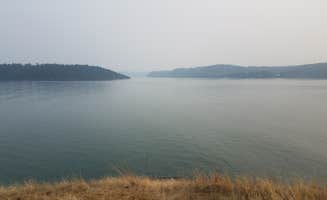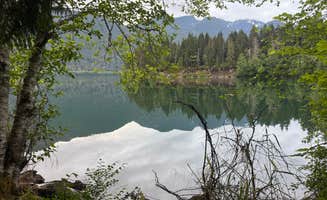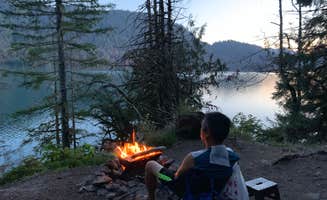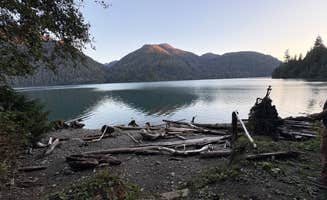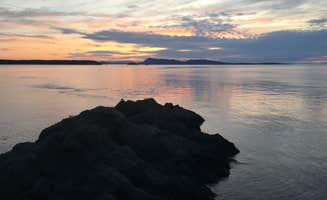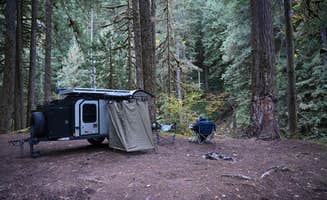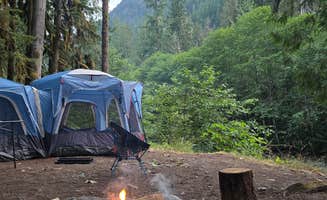Dispersed camping near Clearlake, Washington encompasses several public land areas within Mount Baker-Snoqualmie National Forest, where elevations range from 800 to 3,000 feet. Most primitive sites in this region require a Northwest Forest Pass or America the Beautiful Pass displayed in vehicles. Water access represents a primary draw for many campers, with Baker Lake serving as a central feature with varying water levels depending on seasonal dam operations.
What to do
Watercraft activities: Baker Lake provides multiple access points for kayaking and boating. At Hope Island Marine State Park - Skagit County, visitors must plan carefully for water conditions. As Jess G. notes: "We kayaked to the island, the waters were pretty rough so I would recommend for anyone planning to stay here to look into the waters, tide and wind report the day of. Or if you have the option of using a motorized boat!"
Hiking opportunities: Several trail networks connect to dispersed camping areas. Near NF Dispersed Camping, visitors can access multiple trail systems. One camper mentions: "Took a nice stroll along the road after dinner. Didn't really run into any other campers." Many sites serve as basecamps for North Cascades National Park exploration.
Wildlife viewing: Baker Lake and adjacent waterways offer chances to see diverse wildlife. At Hope Island Marine State Park, campers report seeing marine mammals: "There were some sea lions swimming around in the area but never actually approached the land." River corridors near Mountain Loop Highway also provide wildlife viewing opportunities.
What campers like
Lakefront access: Many dispersed sites around Baker Lake provide direct water access. At Lower Sandy Dispersed Camp, Jessica M. found: "Loved this free campground on Baker Lake near mt baker, WA! Take the first turn after horseshoe cove campground and follow the gravel road all the way to the lake." Sites vary from waterfront to forest settings.
Solitude between sites: Despite popularity, many dispersed areas maintain separation between camping spots. At Baker Lake Road Dispersed Campsite, one camper observed: "Many pull offs along the gravel road. Stayed at one that was overlooking the lake. Lots of spots with easy lake access." Weekdays typically offer greater solitude.
Natural features: Stream access, mountain views and forest settings enhance camping experiences. Near Mountain Loop Highway dispersed areas, campers appreciate the "meandering sites along the river with good logs for benches and fire rings made from forest rocks. Heavily forested and beautiful."
What you should know
Road conditions vary significantly: Access to many sites requires careful vehicle consideration. At Mountain Loop Hway Dispersed Camp, Bobby J. discovered: "Once the highway turned into a gravel road is when I started seeing nice dispersed campsites." For NF-1062 access roads, one visitor states: "CLEARANCE NEEDED - around the same amount as the Subaru line of vehicles or greater - 4wd not necessary."
Site maintenance inconsistencies: User care for primitive sites varies widely. Lauren M. observed: "Both sites were straight up trashed! Trash everywhere!!! The site closer to hwy 20 had both trash and food debris (pineapple and coconut shell) everywhere." Practice leave-no-trace principles.
Limited facilities: Most dispersed areas have minimal or no facilities. Lower Sandy Camp offers some amenities as Jessica M. notes: "Lots of spots with tables and fire rings, some spots have nice tent pads. Some sites are marked and some are not. There's a single pit toilet and no running water."
Tips for camping with families
Site selection strategy: For families, certain areas offer better amenities and safety features. At Baker Pull-Off, a visitor found: "There's 2 little walkways down to your own little private section of the lake. Beautiful." These accessible water areas work well for children.
Timing considerations: Weekdays provide significantly less crowded conditions for family camping. As Douglas H. observes about Baker Lake Road: "Late July, there's a lot of partying on the lake. It's not so bad but you'll definitely hear people having fun."
Supply planning: No potable water exists at most sites, requiring families to bring all necessary water. Many sites sit 20-30 minutes from the nearest store, making advance preparation essential. Local wildlife includes raccoons, as one camper at Hope Island noted: "There were raccoons on the island with us but other than that we had the place to ourselves."
Tips from RVers
Size limitations: Most dispersed sites accommodate smaller rigs only. Near Baker Lake Tent camping, RVers should note: "Didn't stay here but hiked in it and it's very spacious. There are 2 fire rings set up with an upper and lower camping option." Standard RVs generally cannot access tent-only areas.
Leveling challenges: Finding level spots presents difficulties at many locations. At Baker Lake Road Dispersed Campsite, Reagan S. found: "Not super level, but worked with limited options available." Bringing leveling blocks helps at most locations.
Road width considerations: Many access roads have tight turning radiuses. For Mountain Loop Highway sites, travel trailers under 20 feet fare best, as the "driveway is a little rough but I made it in a car." Larger rigs should stick to established campgrounds rather than dispersed options.


